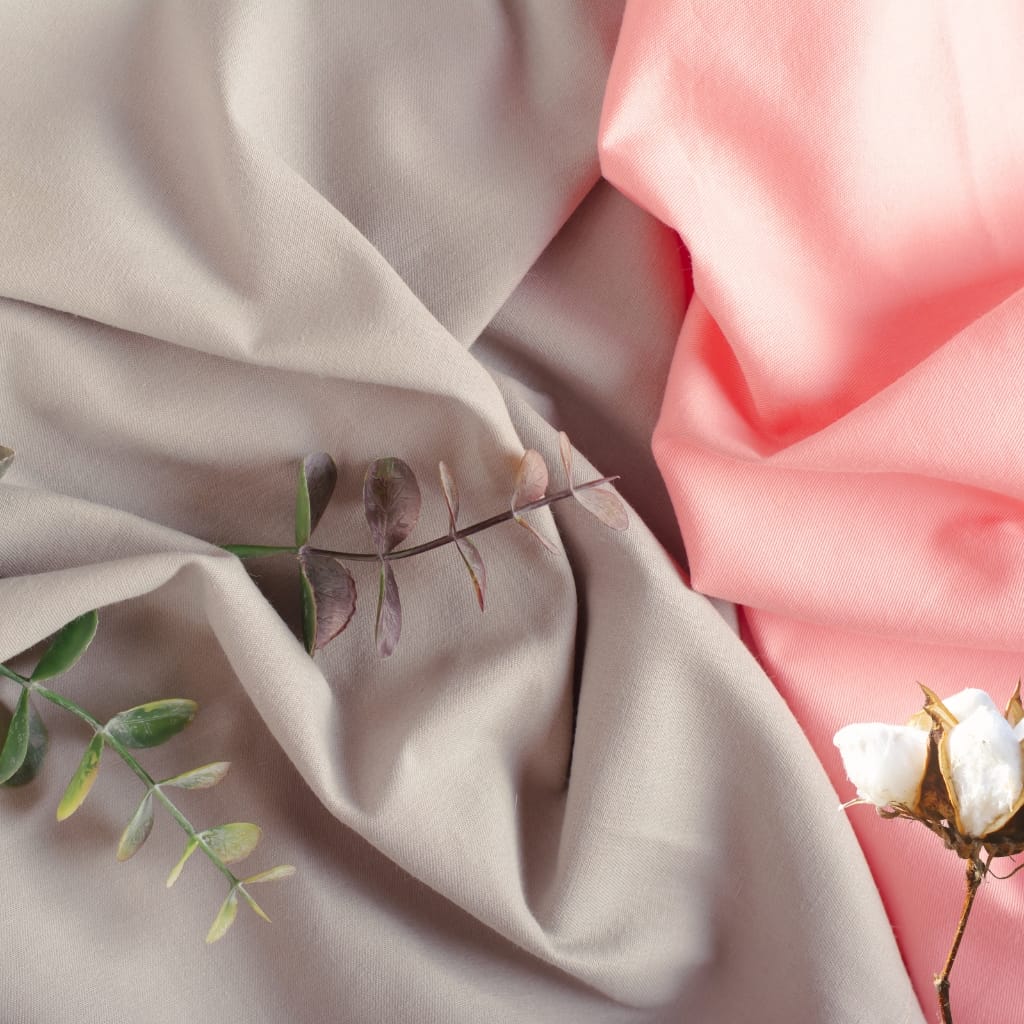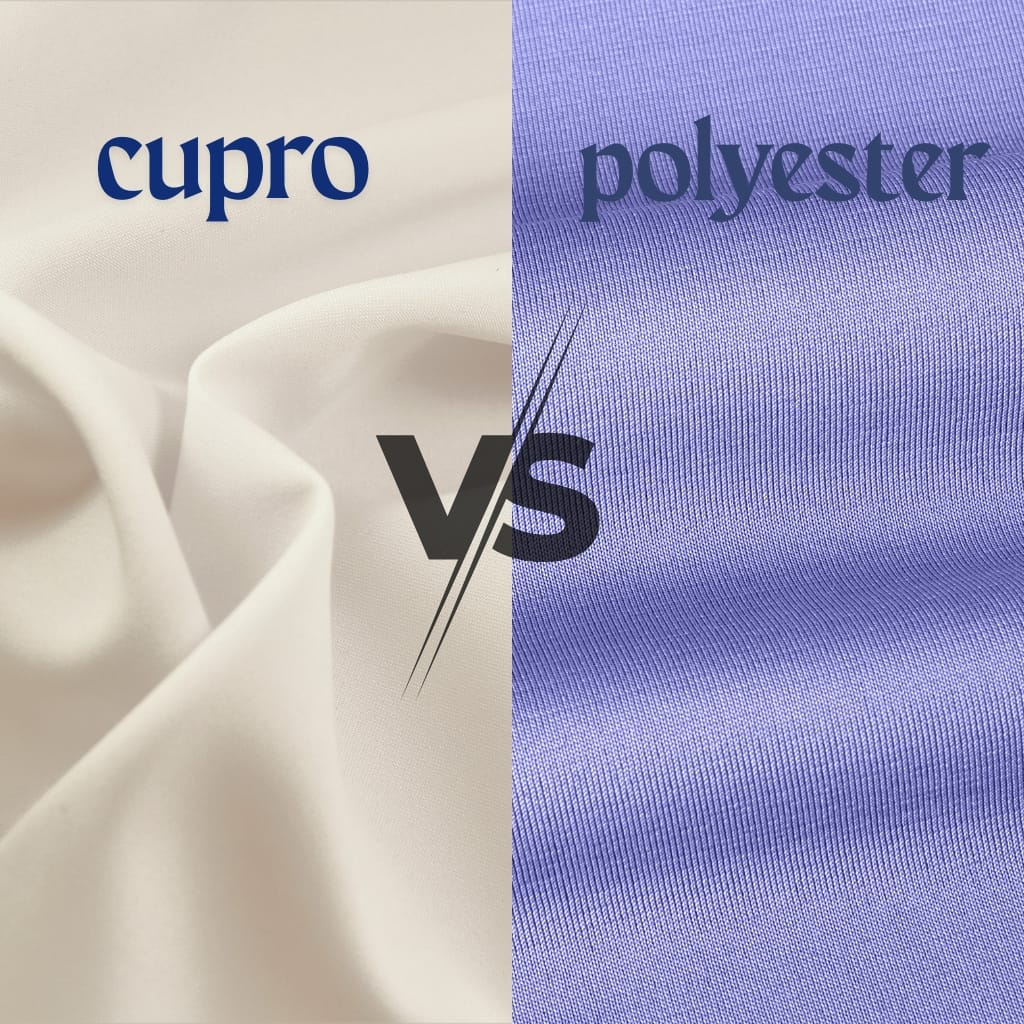Cupro (short for cuprammonium rayon) is an regenerated cellulose fabric that is made of cotton linter — tiny fibers that remain when cotton is taken out for harvest. Instead of going to waste they transform through a closed loop process into a silky comfortable fabric that feels silky and soft upon the skin.
Incredibly in spite of its silk-like appearance, Cupro is entirely plant-based. It is therefore a vegan alternative to silk. It is sometimes called “vegan silk” because of its drapey elegance and soft feel.
Table of contents
- The Origins and History of Cupro
- Cupro vs Other Eco-Friendly Fabrics
- How is Cupro Fabric is made from cotton Waste
- Is Cupro Really a Byproduct of Cotton?
- Closed-Loop Production Explained
- Is Cupro Fabric Biodegradable and Sustainable?
- Chemical Use in Cupro Fabric Creation
- Water Consumption Compared to Other Fabrics
- Cupro vs Silk: Which One Is Kinder to Earth?
- Cupro vs Polyester: Natural vs Synthetic Debate
- Softness, Breathability, and Feel of Cupro
- How Cupro Is Changing Sustainable Fashion Design
- High-End Brands That Use Cupro Fabric
- Cupro Fabric in Vegan Fashion
- Cupro for Summer and Winter Wear
- How to Identify Genuine Cupro in Clothing
- Is Cupro Worth the Price?
- How to Wash and Care for Cupro Clothing
- Is Cupro Truly 100% Eco-Friendly?
- Environmental Concerns of Copper-Ammonia Processing
- Longevity and Wearability of Cupro Clothes
- Emerging Cupro Blends and Tech Advancements
- Cupro in Circular Fashion Models
- Cupro’s Role in Future Textile Innovations
- Conclusion
- FAQs
The Origins and History of Cupro
Cupro isn’t new. It was created more than 100 years ago by Japan. Bemberg(tm) among the best well-known Cupro brands has been manufacturing this fabric for a long time. But, only in recent years has it gained attention as a sustainable choice in the fashion industry.
In the current global trend towards ethical sourcing and reducing textile waste, Cupro’s story is being written again — this time as a way to reduce the impact of fashion on the environment.

Cupro vs Other Eco-Friendly Fabrics
To truly appreciate Cupro’s benefits and benefits, it is helpful to compare it to other eco-friendly fabrics. For instance, organic cotton for instance has less chemicals, but still requires lots of water. Bamboo is a fast-growing, renewable plant however, its processing may require harsh chemicals.
Cupro stands out due to the fact that it converts the waste product into money. Cupro makes use of cotton linter, an unproductive byproduct with very little worth. Additionally, the chemical processing takes place using a closed-loop process this means that the chemicals can be reused rather than discarded.
How is Cupro Fabric is made from cotton Waste
The Cupro production process starts with a cotton linter. The fine fibers are too tiny to make traditional threads of cotton. Instead of throwing them away companies dissolve them in a copper-ammonia mixture. The resulting solution is then extruded into fibers which can be made into thread.
The thing that makes this process distinctive is the fact that it doesn’t create enormous waste. The method that is used to break down the linter is reclaimed, cleaned and re-used — which makes it more eco-friendly than viscose or rayon.

Is Cupro Really a Byproduct of Cotton?
Yes, and that’s certainly one of the most exciting advantages of Cupro. Instead of generating a completely different crop Cupro brings new life into what was previously agricultural waste. This makes it an excellent example of upcycling, which is recycling waste that is of little value and transforming it into valuable products that can be used.
Closed-Loop Production Explained
A closed loop process means that nearly all chemicals and solvents that are used in the production process are reused and reused. This significantly reduces the amount of pollution and helps keep hazardous waste from the waterways. Cupro is a great choice, particularly in comparison to other fibers that are regenerated and produce toxic byproducts from production.
Is Cupro Fabric Biodegradable and Sustainable?
Cupro is completely biodegradable. Since it’s composed of the natural fiber cellulose (plant fiber) and is naturally decomposable, it can be decomposed when it is composted in the right conditions. Additionally, because it is processed in closed loop systems it scores high in terms of sustainability -way above the typical rayon and polyester.
Chemical Use in Cupro Fabric Creation
The method of copper-ammonia used to dissolve cotton linter can make people squirm. But, unlike the earlier methods for rayon the present one is able to recycle and capture the chemicals that are used. Although it isn’t completely free of environmental impacts, this method minimizes the footprint if taken care of.

Water Consumption Compared to Other Fabrics
The use of water for Cupro production is very minimal, particularly when compared with thirsty crops like cotton. Additionally, because Cupro does not require any additional farming or irrigation as well as pesticides, its total footprint on water is relatively low.
Cupro vs Silk: Which One Is Kinder to Earth?
Silk production involves boiling of silkworms, an approach that is not popular with people who are vegan or other animal rights activists. Cupro is a plant-based product and biodegradable, is an eco-friendly and compassionate alternative. It provides the same shine, drape and softness as silk, but without harming animals.

Cupro vs Polyester: Natural vs Synthetic Debate
Polyester is made up of petroleum and requires many years of time to break down. Cupro is unlike polyester is broken down over months. While polyester releases microplastics to the ocean, Cupro decomposes safely, so it is the best choice for environmentally conscious consumers.

Softness, Breathability, and Feel of Cupro
Cupro is extremely smooth and cool against the skin. It breathes like cotton, and is draped like silk. What’s the result? A fabric that is elegant comfortable, sweat-free, and skin-loving. It’s commonly used for clothes, linings as well as dresses and scarves because of its elasticity.
How Cupro Is Changing Sustainable Fashion Design
Designers are in the love of Cupro because of a variety of reasons. It absorbs dye beautifully which results in vibrant and vibrant shades. It is resistant to static, flows smoothly and won’t stick to the clothes. It’s a great choice for clothing that requires flexibility, style and ease of wear.
High-End Brands That Use Cupro Fabric
Famous brands like H&M Conscious Collection, Stella McCartney as well as Mara Hoffman have integrated Cupro into their collections. They recognize the potential of Cupro to combine sustainability and luxury which was once considered to be in contradiction.
Cupro Fabric in Vegan Fashion
This fabric is a favorite of the vegan fashion industry. Since it’s not made from the byproducts of animal production, it fits perfectly with the principles of non-violence. Furthermore, it doesn’t compromise the luxury that makes it perfect for ethical, however fashion-conscious buyers.

Cupro for Summer and Winter Wear
Due to its breathable characteristics, Cupro is perfect for summertime.
It’s also great for layers in cooler seasons. It is a great match with warm fabrics such as wool and offers the comfort of wool without adding weight.
How to Identify Genuine Cupro in Clothing
Genuine Cupro is typically referred to by the name of “Bemberg” or “cuprammonium rayon.” If you’re not sure you should feel the fabricthe fabric should be soft and breathable. It should also feel like silk. Certain tags also refer to “eco-friendly” or “plant-based” fabric.
Is Cupro Worth the Price?
Cupro is typically more expensive than polyester or cotton but it is less expensive than silk.
If you consider its eco-credentials, ease of use, and flexibility, many people consider it to be worth the price. Plus, you’re supporting sustainable practices.
How to Wash and Care for Cupro Clothing
Cupro is very delicate. Always verify the label. The majority of items should be hand washed or washed with gentle cycles using cold water. Drying by air is recommended. Iron at a low temperature in the event of need.
Is Cupro Truly 100% Eco-Friendly?
But not completely- none of the textiles are. Even though Cupro makes use of chemicals, the closed loop system reduces a lot of the environmental costs. In comparison to polyester and conventional rayon, Cupro is a lot greener.
Environmental Concerns of Copper-Ammonia Processing
Yes, chemical usage is used. But the solvents are reclaimed and recycled. If the controls are in place, environmental impact is reduced. Although it’s not perfect, it’s an important step in the proper direction.
Longevity and Wearability of Cupro Clothes
Cupro is a strong, yet gentle substance. It is able to last for years when properly cared for. But it’s not as strong like synthetic fibres. Careful use and gentle handling is the key to prolonging the life span of this material.
Emerging Cupro Blends and Tech Advancements
Mixing Cupro along with organic cotton, or mod enhances the durability and texture. Certain innovations even blend Cupro and recycled polyesters to create sustainable hybrid textiles. Researchers are also improving the finishing techniques and dyeing techniques.
Cupro in Circular Fashion Models
Cupro’s recycling capabilities are perfect for circular economic models. Brands can gather old clothes and turn them into new fibers. This can reduce waste in landfills and allows fashion to be truly circular.
Cupro’s Role in Future Textile Innovations
As the demand for organic, sustainable products, Cupro will continue to grow. Expect to see it used in everything from home textiles to activewear. It’s only a matter the time until Cupro is an essential part of sustainable design.
Conclusion
Cupro isn’t an all-purpose silver bullet, but it’s definitely a useful instrument in sustainable fashion’s arsenal. Cupro turns the waste into fashionable art. It combines elegance and ethics. It gives hope to an industry ripe for change.
Read a detailed content 8 common cotton fabric
FAQs
Cupro is made from cotton linter, the short fibers that remain after cotton is harvested.
In terms of sustainability and silk-like feel, yes. However, cotton is more durable.
Yes, it can if washed improperly. Use cold water and avoid tumble drying.


